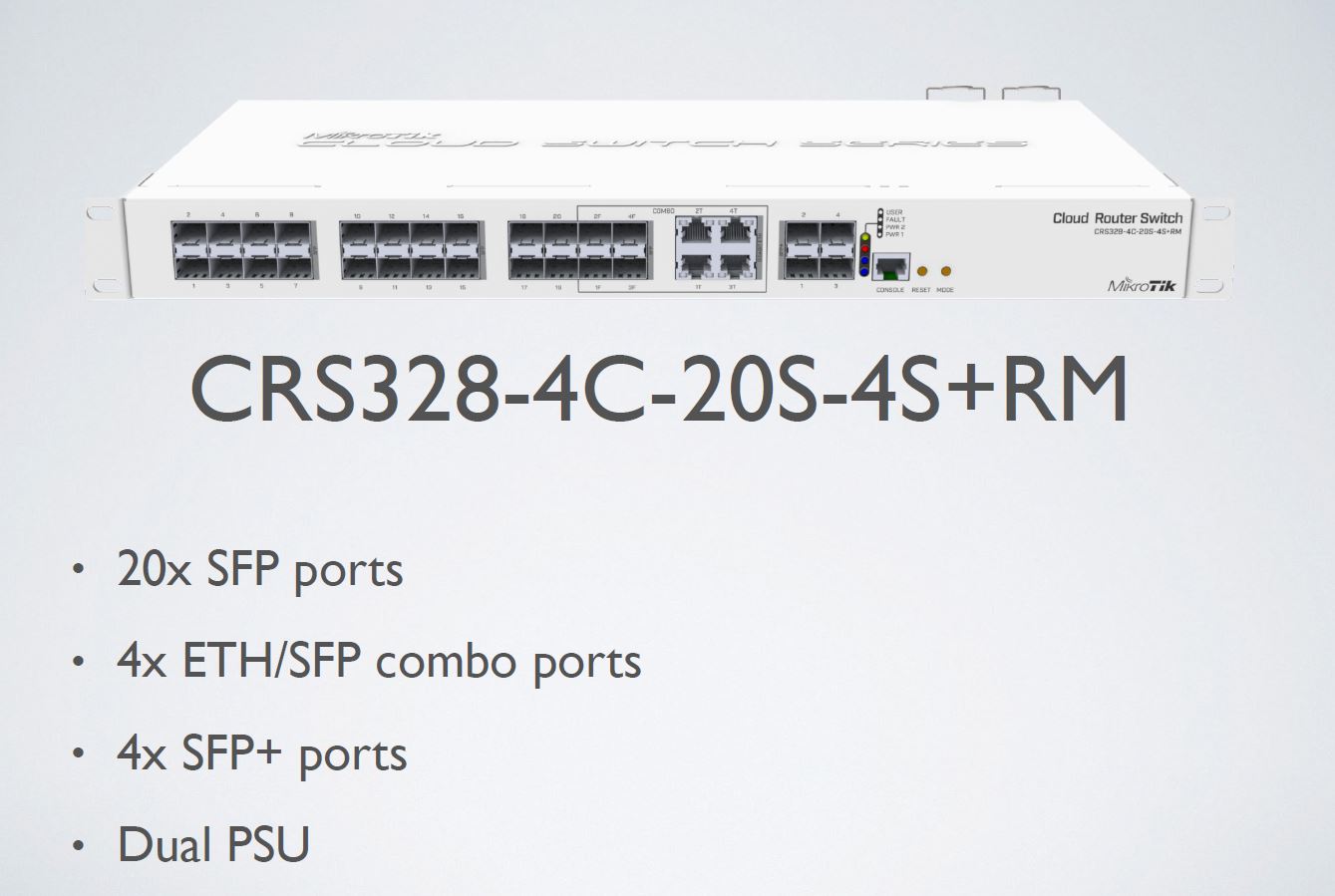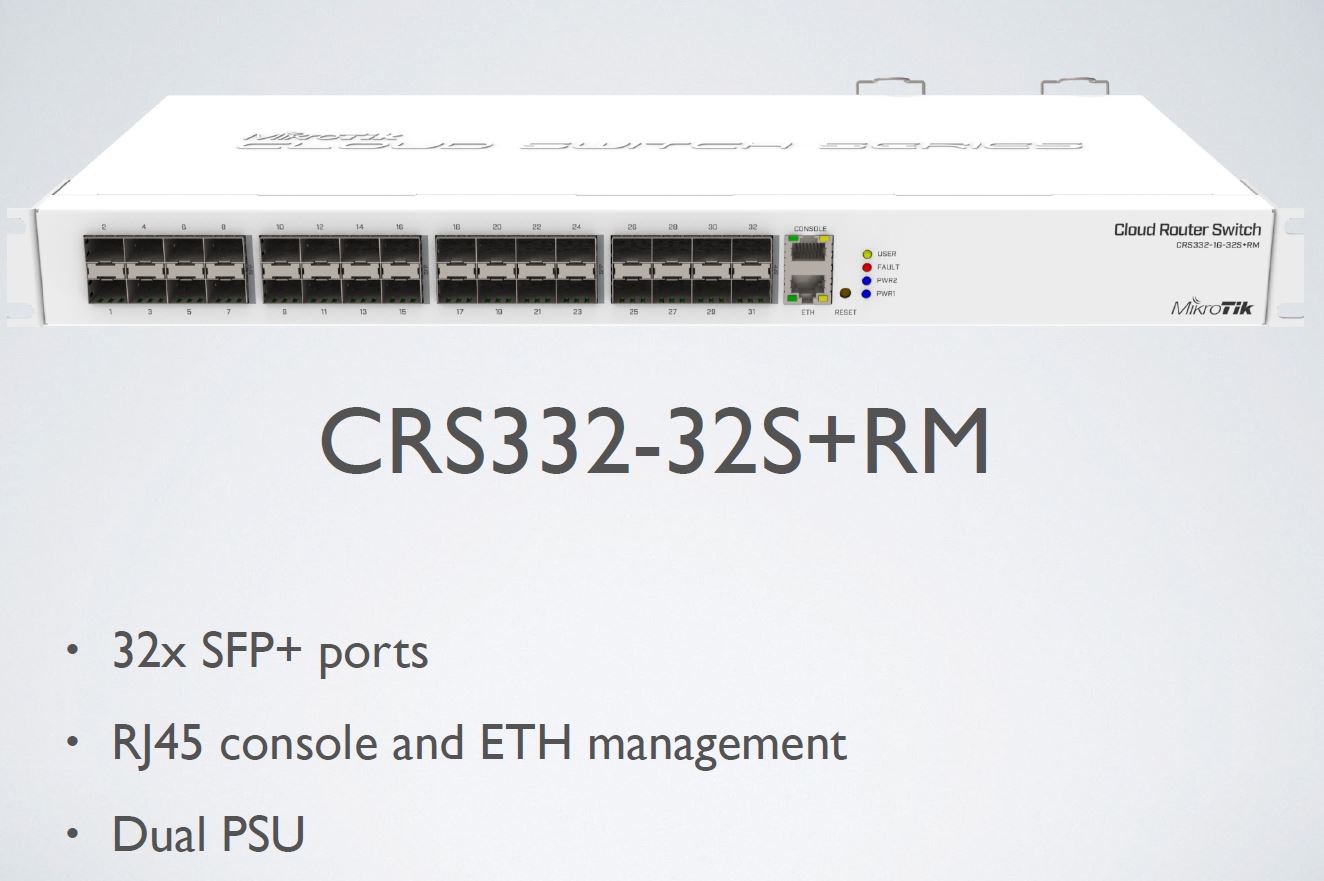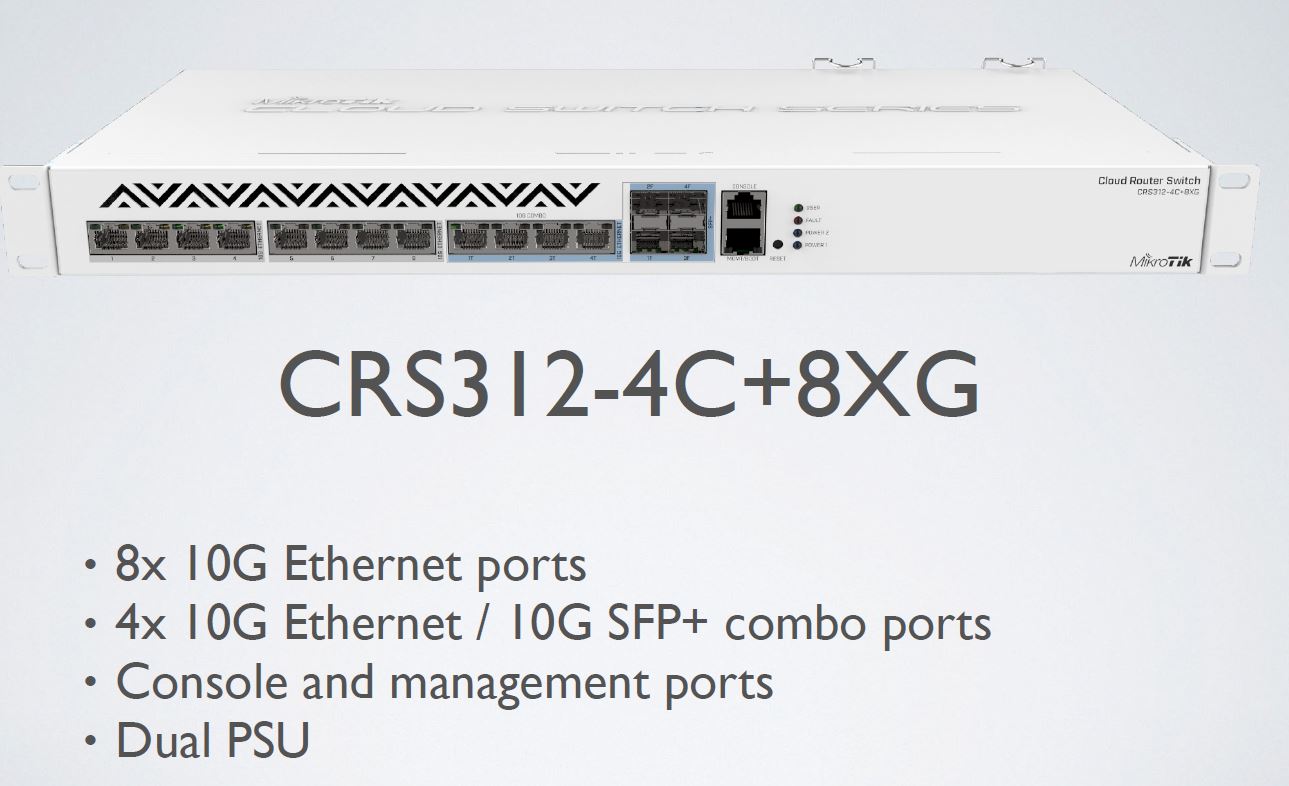MikroTik CRS328-4C-20S-4S+RM
For those that need to cover longer distances, the MikroTik CRS328-4C-20S-4S+RM offers up to 24x SFP ports for optical 1GbE and 4x SFP+ 10GbE ports. Two of the SFP ports are combo ports that can instead be used with standard RJ-45 copper termination.

Rounding out the feature set is dual internal PSUs for redundancy.
MikroTik CRS332-32S+RM
Also at the higher-end of the spectrum is a 32 port 10GbE switch called the MikroTik CRS332-32S+RM. This rackmount switch features 32x SFP+ ports.

This is another switch that is significantly faster than the 1GbE plus a few 10GbE port switches we have seen from MikroTik in the past.
MikroTik CRS312-4C+8XG
When looking at the MikroTik MikroTik CRS312-4C-8XG you can see something that is really different. This is a 12 port switch, but 10Gbase-T instead of primarily SFP+. Four of the twelve ports can be used as SFP+ ports for 10GbE instead.

Rounding out the features are management ports and redundant power supplies.
Final Words
MikroTik is not the largest networking vendor but it does have a loyal following and is well-known for its focus on providing low-cost solutions. Most server platforms today have 10GbE capabilities in the chipset, down to the Intel Atom C3000 series. As a result, the number of 10GbE capable devices is soaring and it makes sense that MikroTik is capitalizing on that segment. Although traditional enterprise switches have been in the market longer and have more robust feature sets, MikroTik has an ace up its sleeve: a GUI management. Many switches in the segments MikroTik is targeting have only CLI interfaces. For SMB service providers who may deploy these switches, the GUIs that MikroTik supplies are going to be a welcome differentiator. If you are still using 1GbE in 2018, you are past due for an upgrade and MikroTik has you covered.




When are these switches going to be released?
Nice article, but the last sentence is just so so. For example, yep, in 2018 I’m purchasing 1GigE switch. Why? You can’t find any 10 GigE which would be fan-less. One of exceptions is one from MikroTik. (CRS326 something…). But if you look into performance sheet, they supply only up to 1GigE throughput numbers. Why? Isn’t it possible to switch 10GigE wirespeed? Also hardware is really limited. Just 16MB FLASH. That means they seriously limit their ability to add new features. I’m comparing all this with Cisco SG250/350. The amount of features on Cisco is simply stunning — especially on SG350. The problem is it’s more than twice the price of MikroTik and w/o any 10GigE options. So well, although I do have Cat6A cables and keystones everywhere I’ll still probably buy Cisco since MikroTik looks kind of strange on the switch side…Pity, but such is life…
> But if you look into performance sheet, they supply only up to 1GigE throughput numbers. Why? Isn’t it possible to switch 10GigE wirespeed?
Not true: it is switching at 10G, but routing at 1G speeds.
By the way, if you like the SG350 series, look at the SG350X. Can be had at good prices when you search for it. It is a better featured switch than the mikrotik (very nice when stacked, I use it that way), but still not in the league of the bigger boys (small buffer, language crippled, and the DHCP server is simply unusable). A LOT noisier than the CRS317 I have though (which is completely silent after boot), even with retrofit low noise fans.
My take at it: 10G L2/L2+ switching is affordable now, especially with this new mikrotik range. L3 on 10G is still costly.
Hans,
thanks a lot for your comment which lead me to another investigation and I’ve found you are partially right. Let’s have a look on CRS326 numbers: https://mikrotik.com/product/CRS326-24G-2SplusRM#fndtn-testresults
You are right that L2 switching numbers are way higher than L3 bridging/routing numbers. On the other hand if you count with required switching capacity for provided ports, then you have 24 x 2Gbits + 2x 20Gbits. I’m counting with full-duplex hence twice the port speed. This leads to 24 * 2 + 2 * 20 = 88 Gbps switching capacity. If you look into perf. numbers, you see that only “Switching …. capacity” provides this, but “Switching …. throughput” is kind of limited to ~45 Gbps. Why is that?
That’s with regarding to Mikrotik. Anyway, you convinced me that the hardware is pretty capable, now the question is how good (i.e. bug-free) VLAN implementation is…
W.r.t. Cisco SG350 and upgrade to SG350X, in fact I went in opposite direction from SG350X which I would loved to have to just SG350 and the reason was declared noise level produced by builtin fan on SG350X. Otherwise this switch would be my hottest candidate. Thanks a lot for your note about actual noise comparison between SG350x and CRS317. That’s something man usually hard to find, especially since Mikrotik provides no measurements in their data-sheets…
Hmm, anyway, I’m very grateful for your comment, I’ll still need to consider CRS326 so it’s back in game.
Thanks!
Karel
CRS326 like most switches has full non-blocking switching performance. Capacity double counts ingress and egress traffic; throughput single counts traffic passing through the switch. L1 throughput is always half of L1 capacity. L2 performance is derated based on framing overhead, exactly as expected.
If you are OK with a web GUI and don’t need routing features, you may also want to consider CSS326, which is lower cost and lower power than CRS326 and still a very capable switch. Both are passively cooled (no fans).
Word has it, MicroTik says it’ll be ready in March 2019. But I won’t hold my breath.
I’d love what doesn’t exist – either a 4 or 8 port 40 or 100g switch. I just want to connect my 4 main systems at faster than 10g